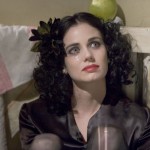Dir. by Brian De Palma
De Palma’s introduction of “The Black Dahlia” (the character, not the film) is a show-stopper. As I recall, the camera begins more or less at eye level, following police officers Bucky Bleichert (Josh Hartnett) and Lee Blanchard (Aaron Eckhart) as they race toward a rowhouse in pursuit of criminals. Rather than going into the building, though, the camera instead floats up and over it, pausing for only a few seconds as it spots the Dahlia off in the far distance. There she is: the nude, disemboweled, disfigured body; the image that, if you’ve ever seen it in oft-duplicated black and white, is likely seared into your memory. (Here’s the image I first saw in a bookstore copy of Hollywood Babylon when I was way too young. Scroll down. Warning: graphic content.)
A woman spots the Dahlia’s remains, screams, and then runs into traffic, crying for help. De Palma at first appears to be following her. “Twenty minutes into a film called The Black Dahlia we’re finally going to get to her story,” we think, relieved. But De Palma’s not interested in the frantic woman; he doesn’t appear, even, to be concerned with the victim. Instead, his camera, in a continuing, unbroken shot, chases after a bicyclist, who leads the crane back down and around the building, back, eventually, to Bucky and Lee, our main characters. Another five minutes or so pass before there is any mention of the poor woman whose mutilated body lies in the grass a few hundred feet away.
I’m nowhere near deciding yet whether or not The Black Dahlia is good, but it’s certainly among the strangest and most fascinating Hollywood films I’ve seen in quite some time. As we were walking out of the theater last night, Joanna asked the key question, and I’m still wrestling with it: “That was supposed to be a satire, right?” I’m not sure if “satire” is the right word, exactly, but The Black Dahlia is self-aware to the point of distraction. (Poor Scarlett Johansson comes close to out-Showgirls-ing Elizabeth Berkley.) I haven’t done much reading about the film yet, but I do recall seeing one comparison to A History of Violence, which seems about right. Like Cronenberg, De Palma has made a decent-enough genre film that comments constantly on the genre itself — not in a snarky, wink-wink way but, rather, with a bit of bite.
Noir has always been ripe for psychoanalytic readings, as have many of De Palma’s films, especially those that are more explicitly Hitchcock-inspired. What I find so interesting about The Black Dahlia is its making real and visible what has been suppressed in so many of the films that preceded it. In one sense, The Black Dahlia isn’t about “The Black Dahlia” at all. (That was Joanna’s main disappointment. She wanted an account of the murder that stayed within the wide bounds of established fact, and became frustrated when the film didn’t match her expectations.) And yet, one could also argue that every noir is about “The Black Dahlia” — namely, she is an embodiment (with all of the troubling connotations attached to that word in this context) of noir desire. She’s a hyper-sexualized femme fatale, dangerous and beautiful, the subject of our voyeuristic gaze, a helpless victim and sly manipulator, and a site of horrific violence. Now, in 2006, “The Black Dahlia” is also infected with sensationalism. She’s not just a murder victim; she’s the murder victim who was photographed and whose photographs have entered the public consciousness. She’s a media event. (Just imagine what Nancy Grace would have done with this story.)
Traditionally, Film Noir heroes have been haunted by this repressed desire. (Hell, some would argue that this particular ghost infests all of cinema. I’m talkin’ to you, Mulvey.) Well, repression be damned. In the closing moments of The Black Dahlia, when Bucky returns for one final reunion with Johansson’s icy blonde Kay, De Palma kicks the proverbial psychic doors wide open. Bucky, who has been betrayed at every turn and who has just committed a sex-charged act of violence himself, sees the high-contrast, severed remains of “The Black Dahlia” everywhere he turns. In what I can only assume is meant to be a joke, he’s rescued from his reverie, finally, by Kay’s none-too-subtle invitation to “come inside.” I thought it was funny, at least.
